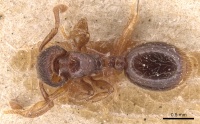Myrmecina sicula
| Myrmecina sicula | |
|---|---|

| |
| Scientific classification | |
| Kingdom: | Animalia |
| Phylum: | Arthropoda |
| Class: | Insecta |
| Order: | Hymenoptera |
| Family: | Formicidae |
| Subfamily: | Myrmicinae |
| Tribe: | Crematogastrini |
| Genus: | Myrmecina |
| Species: | M. sicula |
| Binomial name | |
| Myrmecina sicula André, 1882 | |
Nothing is known about the biology of Myrmecina sicula.
Identification
Rigato (1999) - Emery (1916) quite carefully redescribed this ant and raised it to species. He showed the main characters separating Myrmecina sicula from Myrmecina graminicola, and stressed the importance of the reduction of the median tooth of the clypeus; as reported in the current description (Rigato 1999) this character is inconsistent. For this reason Menozzi (1936) thought of Myrmecina sicula as a trivial variant of graminicola. Myrmecina sicula appears unique for the contrast between the smooth promesonotum and the dull head, while in the related taxa the head and alitrunk are similarly sculptured.
Keys including this Species
Distribution
Latitudinal Distribution Pattern
Latitudinal Range: 38.122222° to 37.5°.
| North Temperate |
North Subtropical |
Tropical | South Subtropical |
South Temperate |
- Source: AntMaps
Distribution based on Regional Taxon Lists
Palaearctic Region: Italy (type locality).
Distribution based on AntMaps
Distribution based on AntWeb specimens
Check data from AntWeb
Countries Occupied
| Number of countries occupied by this species based on AntWiki Regional Taxon Lists. In general, fewer countries occupied indicates a narrower range, while more countries indicates a more widespread species. |

|
Estimated Abundance
| Relative abundance based on number of AntMaps records per species (this species within the purple bar). Fewer records (to the left) indicates a less abundant/encountered species while more records (to the right) indicates more abundant/encountered species. |

|
Biology
Castes
Nomenclature
The following information is derived from Barry Bolton's Online Catalogue of the Ants of the World.
- sicula. Myrmecina latreillei var. sicula André, 1882c: 275 (w.) ITALY (Sicily). De Stefani, 1889: 144 (m.). Raised to species: Emery, 1916a: 59. See also: Baroni Urbani, 1971c: 96; Rigato, 1999: 88.
Unless otherwise noted the text for the remainder of this section is reported from the publication that includes the original description.
Rigato (1999) - Unfortunately, it seems that the two males reported by De Stefani (1889) have been lost. I hope that some fresh samples of this interesting ant will be collected in the near future.
Description
Worker
Rigato (1999) - Lectotype, here designated, specimen deposited in Musee National d'Histoire Naturelle: TL 3, HW 0.65, HL 0.68, CI 96, SL 0.57, SI 88, PW 0.44, AL 0.81.
Head mostly opaque. finely reticulate-punctate with superimposed irregular longitudinal rugulae which diverge toward the occiput. The rugulae are clearly less strong than is usual in Myrmecina graminicola. Alitrunk dorsally with a smooth promesonotum (very faintly superficially reticulate). Propodeum feebly sculptured; sides with longitudinal irregular rugae (as usual for the other species dealt with in the present work). Petiole and postpetioIe with few longitudinal rugulae and a weak ground sculpture. Gaster smooth with a very superficial reticulation. Colour bright orange, gaster brown.
Paralectotype (specimen with the same data as the lectotype. deposited in the Museo Civico di Storia Naturale, Genoa): TL 3. HW 0.66. HL 0.69, CI 96, SL 0.56, SI 85, PW 0.44, AL 0.84. The only noteworthy difference from the lectotype are the well developed anteropropodeal processes which rise from the profile of the alitrunk as a low tooth.
Type Material
Rigato (1999) - Syntype workers. ITALY: Palermo (De Stefani) (Musee National d'Histoire Naturelle, Museo Civico di Storia Naturale, Genoa) [examined]. As stated by De Stefani (1889) and Emery (1916). the only known specimens of this taxon are the two type workers of which one is deposited in the MNHN and the other in the MCSNG. For this reason I have preferred to designate as Lectotype the specimen of the MNHN, where Andre's collection is stored.
References
- André, E. 1882d. Les fourmis. [part]. Pp. 233-280 in: André, Edm. 1881-1886. Species des Hyménoptères d'Europe et d'Algérie. Tome Deuxième. Beaune: Edmond André, 919 + 48 pp. (page 275, worker described M. latreillei var. sicula)
- Baroni Urbani, C. 1971c. Catalogo delle specie di Formicidae d'Italia (Studi sulla mirmecofauna d'Italia X). Memorie della Societa Entomologica Italiana 50: 5-287 (page 96, see also)
- Borowiec, L. 2014. Catalogue of ants of Europe, the Mediterranean Basin and adjacent regions (Hymenoptera: Formicidae). Genus (Wroclaw) 25(1-2): 1-340.
- Emery, C. 1916b. Formiche d'Italia nuove o critiche. Rend. Sess. R. Accad. Sci. Ist. Bologna Cl. Sci. Fis. (n.s.) 20: 53-66 (page 59, Raised to species)
- Rigato, F. 1999. Myrmecina melonii n. sp., a new ant from Sardinia, with a review of the West Palaearctic Myrmecina (Hymenoptera Formicidae). Boll. Soc. Entomol. Ital. 131: 83-92 (page 88, see also)
- Schifani, E. (2022). The new checklist of the Italian fauna: Formicidae. Biogeographia – The Journal of Integrative Biogeography 37, ucl006 (doi:10.21426/b637155803).
- Schifani, E., Scupola, A., Alicata, A. 2020. Morphology, ecology and biogeography of Myrmecina sicula André, 1882, rediscovered after 140 years (Hymenoptera, Formicidae). Biogeographia – The Journal of Integrative Biogeography 35, 105–116 (doi:10.21426/b635048444).
References based on Global Ant Biodiversity Informatics
- De Stefani T. 1889. Miscellanea imenotterologica sicula. Nat. Sicil. 8: 140-145.
- Emery C. 1916. Fauna entomologica italiana. I. Hymenoptera.-Formicidae. Bullettino della Società Entomologica Italiana 47: 79-275.
- Okido H. 2011. Biogeography of the ant genus Myrmecina from Asia (Hymenoptera; Formicidae). Kankyo Kanri 40: 60-64.
- Poldi B., M. Mei, and F. Rigato. 1995. Hymenoptera, Formicidae. Vol 102. Checklist delle specie della fauna Italiana: 1-10.
- Rigato, F. "Myrmecina melonii n. sp. a new ant from Sardinia, with a review of the West Paleartic Myrmecina." Bollettino della Società Entomologica Italiana 131 (1) (1999): 83-92.

